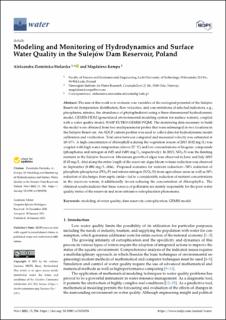| dc.contributor.author | Ziemińska-Stolarska, Aleksandra | |
| dc.contributor.author | Kempa, Magdalena | |
| dc.date.accessioned | 2021-07-16T10:14:08Z | |
| dc.date.available | 2021-07-16T10:14:08Z | |
| dc.date.created | 2021-04-14T14:41:03Z | |
| dc.date.issued | 2021 | |
| dc.identifier.citation | Water. 2021, 13 (3), 296. | en_US |
| dc.identifier.issn | 2073-4441 | |
| dc.identifier.uri | https://hdl.handle.net/11250/2764652 | |
| dc.description.abstract | The aim of this work is to evaluate core variables of the ecological potential of the Sulejów Reservoir (temperature distribution, flow velocities, and concentrations of selected indicators, e.g., phosphates, nitrates, the abundance of phytoplankton) using a three-dimensional hydrodynamic model, GEMSS-HDM (generalized environmental modeling system for surface waters), coupled with a water quality model, WASP EUTRO (GEMSS-WQM). The monitoring data necessary to build the model were obtained from two multiparameter probes that were submerged in two locations in the Sulejów Reservoir. An ADCP current profiler was used to collect data for hydrodynamic model calibration and verification. Total error between computed and measured velocity was estimated at 10–15%. A high concentration of chlorophyll-a during the vegetation season of 2015 (0.02 mg/L) was coupled with high water temperature (above 25 °C) and low concentrations of biogenic compounds (phosphorus and nitrogen at 0.02 and 0.001 mg/L, respectively). In 2015, NO3-N was the limiting nutrient in the Sulejów Reservoir. Maximum growth of algae was observed in June and July 2015 (0.02 mg/L chla) along the entire length of the reservoir; algae bloom volume reduction was observed in September (0.004 mg/L chla). Proposed scenarios for nutrient reduction—50% reduction of phosphate-phosphorus (PO4-P) and nitrate-nitrogen (NO3-N) from agriculture areas as well as 50% reduction of discharges from septic tanks—led to a considerable reduction of nutrient concentrations in the reservoir waters; it additionally favors reducing the concentration of chlorophyll-a. The obtained results indicate that these sources of pollutants are mainly responsible for the poor water quality status of the reservoir and more intensive eutrophication phenomena. | en_US |
| dc.language.iso | eng | en_US |
| dc.publisher | MDPI | en_US |
| dc.rights | Navngivelse 4.0 Internasjonal | * |
| dc.rights.uri | http://creativecommons.org/licenses/by/4.0/deed.no | * |
| dc.title | Modeling and Monitoring of Hydrodynamics and Surface Water Quality in the Sulejów Dam Reservoir, Poland | en_US |
| dc.type | Peer reviewed | en_US |
| dc.type | Journal article | en_US |
| dc.description.version | publishedVersion | en_US |
| dc.rights.holder | © 2021 by the authors. | en_US |
| dc.source.pagenumber | 19 | en_US |
| dc.source.volume | 13 | en_US |
| dc.source.journal | Water | en_US |
| dc.source.issue | 3 | en_US |
| dc.identifier.doi | 10.3390/w13030296 | |
| dc.identifier.cristin | 1904052 | |
| dc.source.articlenumber | 296 | en_US |
| cristin.ispublished | true | |
| cristin.fulltext | original | |
| cristin.qualitycode | 1 | |

